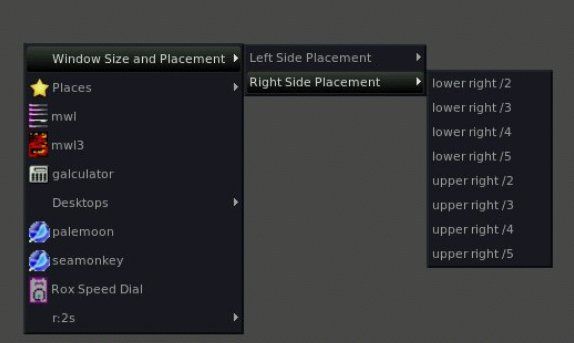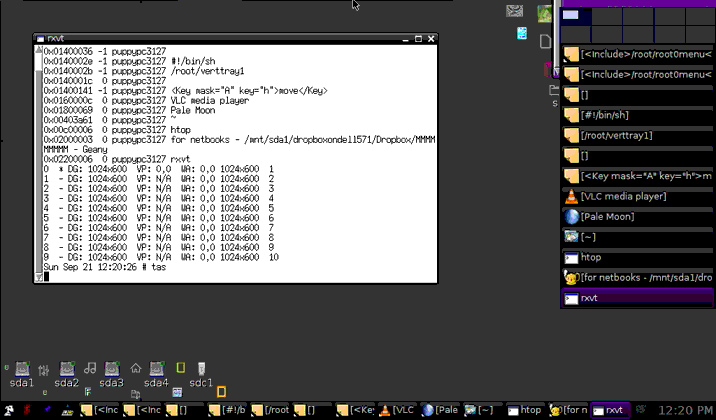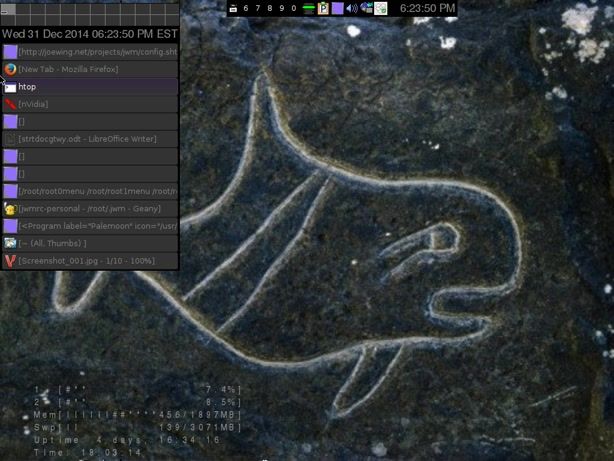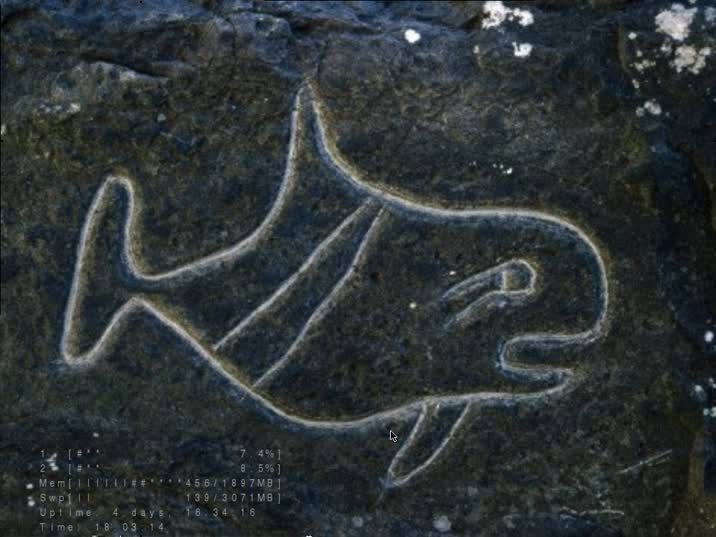Place in .jwmrc-tray or jwmrc-personal just below where you see <JWM> :
Code: Select all
<Include>/root/root0menu</Include>
<Include>/root/root1menu</Include>
<Include>/root/root2menu</Include>
<Include>/root/root4menu</Include>
<Include>/root/root5menu</Include>
<Include>/root/root6menu</Include>
<Include>/root/root7menu</Include>
<Include>/root/root8menu</Include>
<Include>/root/root9menu</Include>
<!-- <TrayButton label="1">root:1</TrayButton> -->
<!-- <TrayButton label="2">root:2</TrayButton> -->
<!-- <TrayButton label="4">root:4</TrayButton> -->
<!-- <TrayButton label="5">root:5</TrayButton> -->
<!-- <TrayButton label="6">root:6</TrayButton> -->
<!-- <TrayButton label="7">root:7</TrayButton> -->
<!-- <TrayButton label="8">root:8</TrayButton> -->
<!-- <TrayButton label="9">root:9</TrayButton> -->
<!-- <TrayButton label="0">root:0</TrayButton> -->
<!-- four and five are scroll up and down; 3 is already your main (right click) menu and one is already left click. the others need to be anchored to something to exist--either shortcut keys or these buttons with the comments (the "<!--" and the "-->" that "hide" the code from the machine) removed. if you're going to use taskbar buttons (rather than the escape key shortcuts suggested below), you may want to add an additional taskbar... --> place in jwmrc-personal:
Code: Select all
<Key mask="A" key="Escape">root:0</Key>
<Key mask="C" key="Escape">root:1</Key>
<Key mask="S" key="Escape">root:2</Key>
<Key mask="AC" key="Escape">root:6</Key>
<Key mask="AS" key="Escape">root:7</Key>
<Key mask="CS" key="Escape">root:8</Key>
<Key mask="SAC" key="Escape">root:9</Key> then run the following script (or just enter the code in a terminal):
Code: Select all
#!/bin/sh
geany /root/root0menu /root/root1menu /root/root2menu /root/root4menu /root/root5menu /root/root6menu /root/root7menu /root/root8menu /root/root9menu /root/.jwmrc-tray /root/.jwm/jwmrc-personal /root/my-applications/bin/9menus
#call this one 9menus and place in /root/my-applications/bin (it could come in handy later).Code: Select all
<?xml version="1.0"?>
<JWM>
<RootMenu onroot="#">
<Desktops></Desktops>
<Include>/root/places_submenu</Include>
</RootMenu>
</JWM>scrolling up will activate the root:4 menu and scrolling down will activate the root:5 menu. you can grab shortcut keys from (for example) tab or backspace if you don't want to rely on that method of calling them.
replace the "#" with the actual number of the root menu being populated in each root#menu file (it may seem obvious, and perhaps it is, but i actually forgot to include the line (and its complement) in the above seven-line code--apologies to any who may have been affected). on the subject of perhaps obvious but maybe worth mentioning: if you've used any of the earlier shortcuts, for example the escape keys for the panels, make sure you delete or overwrite conflicts when replacing them with new versions--little things like that tend to jam things up. run jwm -p in a terminal and you'll get a a readout of any existing problems and where they can be found.
another thing that may be obvious relates to what i mentioned earlier about the left and right click together functioning as a middle click--for about three years, the workaround had me occasionally sitting around like a spazz trying to coordinate the action with my two index fingers on my laptop's trackpad buttons--much easier to just place your finger between the two and press.
edit: i tried to make it easier by including ready-made versions of the 9 root menus suggested above. i included instructions, Mochi's script from page 6, the code that needs to be pasted into the two jwm files, and the little geany script to gather together some of the files you might need:
jwmmenu9pack.tar.gz
The pack above assumes you are going to want to keep your new menu files in /root. if you're keen on changing the location, change the
Code: Select all
<Include>/root/root#menu</Include>___
a bit more on this, root menus, and shortcut keys here.




